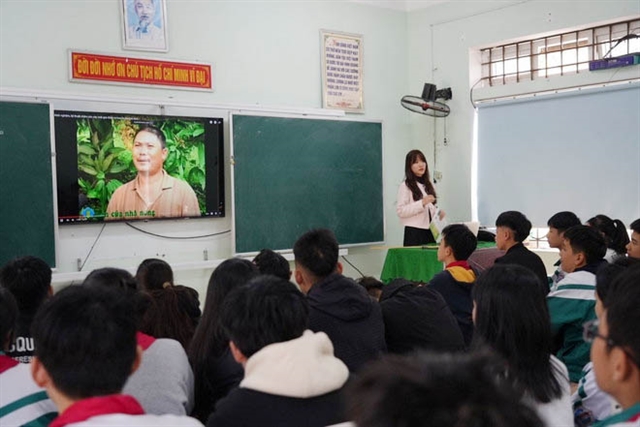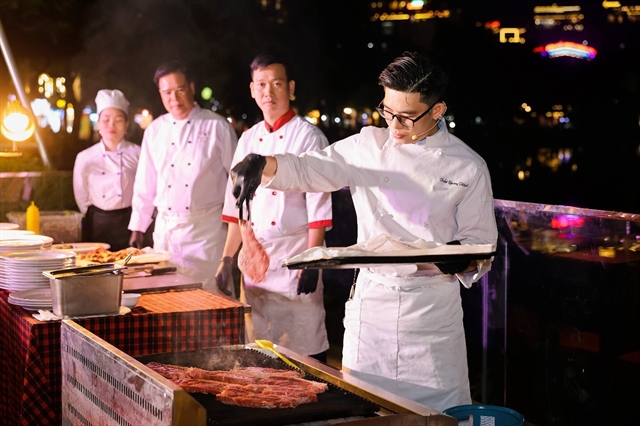 Society
Society

 |
| A lesson in a school of Nam Đàn District. VNA/VNS Photo Bích Huệ. |
VINH — In Nghệ An Province, lessons in local education are coming alive through creative teaching methods that draw directly from the province’s cultural and historical heritage. Rather than being confined to textbooks, students are learning through immersive experiences at museums, historical sites and directly from folk artisans, experts and village elders.
These approaches are aimed at transforming abstract lessons into tangible knowledge, while nurturing pride and love for the homeland.
At Anh Son High School, history teacher Nguyễn Thị Thanh Hương has pioneered a dynamic approach to teaching.
Instead of traditional lectures, her students engage in group work, design presentations and play educational games. Multimedia tools, including slideshows and visual illustrations, make classes more memorable and enjoyable, while offering diverse perspectives on the region’s history and culture.
"Currently, we lack official textbooks for the subject," Hương said, "so we rely on flexible lesson planning and curated local materials to help students understand the history of their homeland."
At the secondary level, however, logistical and financial constraints often prevent field trips. To compensate, teachers design engaging and interactive classroom lessons that still communicate the richness of Nghệ An’s culture.
Many incorporate local customs, folk traditions, and historical narratives to cultivate students’ civic pride and responsibility. At Nguyễn Trãi Secondary School in Tân Kỳ District, for instance, students recently participated in a club activity themed 'March to Sài Gòn', where they learned about the Hồ Chí Minh campaign. They also explored the special national site of 'Kilometre Zero', the starting point of the legendary Hồ Chí Minh Trail.
Beyond the classroom
Local museums have become crucial partners in expanding local education. Schools across Nghệ An are organising visits to museums, where students interact with rich archives, artefacts and meet living witnesses. Museums often collaborate with schools to host games like 'Secret Crossword' and 'Following the Party’s Footsteps', and invite folk artisans to enhance the hands-on experience.
At Huỳnh Thúc Kháng High School in Vinh City, a Grade 12 class recently attended a class called 'The Soul of Ví, Giặm Folksongs.'
Held at the Nghệ An Traditional Arts Centre, students watched performances that brought to life the rhythm, spirit and daily life of the Nghệ An people through folk scenes, call-and-response songs and re-enactments. After the show, students took to the stage themselves, singing, playing instruments and engaging with the artists—an experience that deepened their understanding and love for their cultural roots.
They also met Meritorious Artist Đức Lam, leader of the Nghệ An Ví, Giặm folk group, who shared insights into the genre’s significance and its place in contemporary music. These real-world connections, along with the opportunity for students to perform, left lasting impressions and reinforced cultural preservation values.
In the remote Kỳ Sơn District, folk artist Vừ Lầu Phổng from Tây Sơn Commune has become a regular mentor at the local semi-boarding school for ethnic minority students. Taught by his grandfather from age twelve, Phổng mastered the Mông people’s traditional khen dance and folk songs. Today, he shares this legacy with local youth and his own children.
Alongside Phổng, more than 20 artisans across the region contribute to cultural education. Village elders teach students about their ethnic origins, rituals, musical instruments and dances—offering a rich, living resource that supports schools in delivering cultural content in the curriculum.
Since 2020, the Tây Sơn school has officially incorporated Mông dance, instruments and songs into extracurricular and experiential learning. According to Principal Võ Thị Vinh, these efforts have also helped stabilise school attendance, as nearly all students are Mông children.
A shared mission
Nghệ An’s Department of Education and Training, in collaboration with the Department of Culture, Sports and Tourism, has been implementing local education across all grades, from primary to high school. The curriculum focuses on regional economic strengths, geography, history, and the province’s revolutionary and cultural legacy. Schools partner with museums and heritage sites to deepen students' experience and understanding.
Thành explained that lessons are tailored to each grade level to ensure age-appropriate comprehension. Combining classroom teaching with field trips and interactive programs helps students absorb knowledge selectively and critically, allowing them to resist harmful content while preserving the values of Vietnamese and global civilisation.
In Nghệ An, education is no longer confined to pages. Instead, it comes from living, breathing heritage and the people who embody it. From museums to mountain villages, and from veteran performers to schoolchildren, a shared mission is taking root - to pass on the soul of the homeland to the next generation. — VNS




